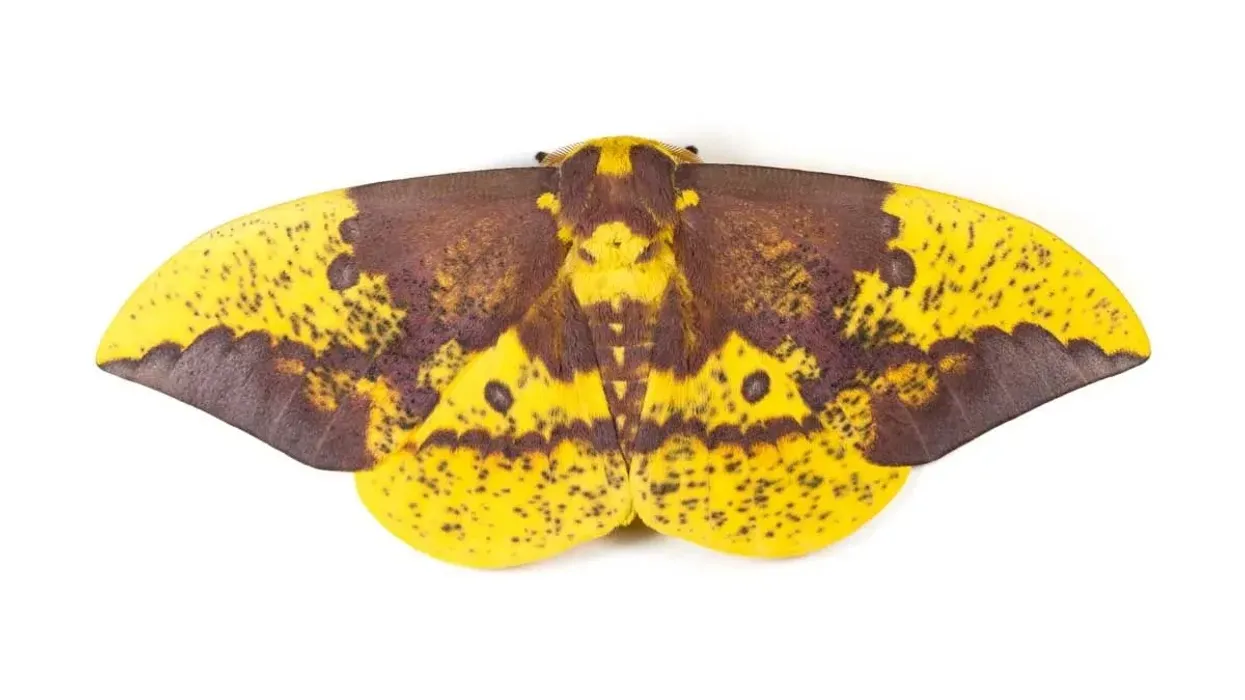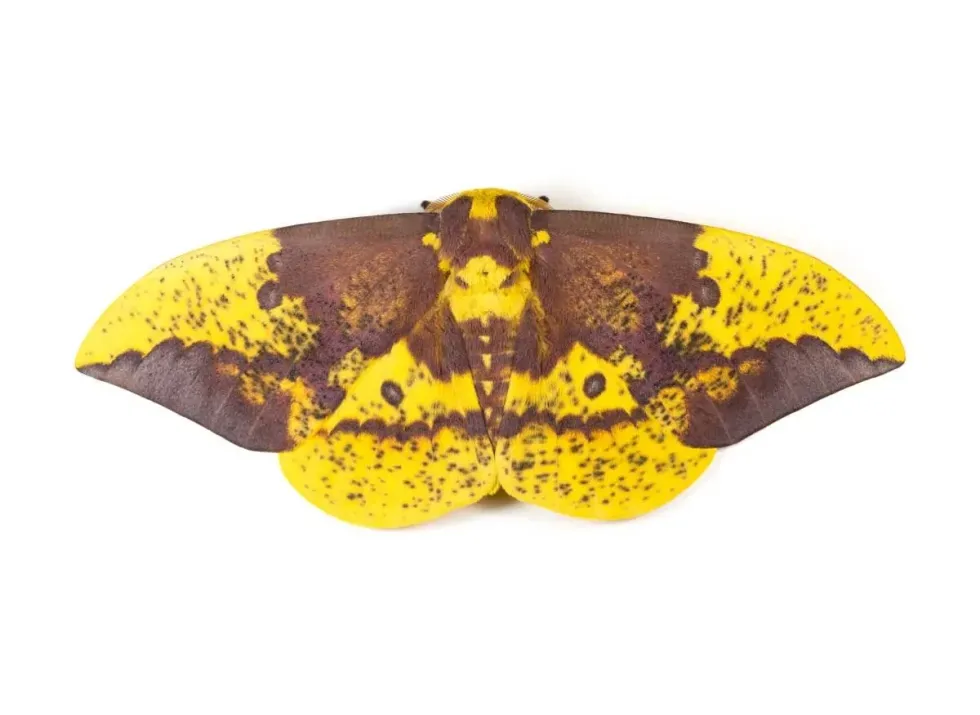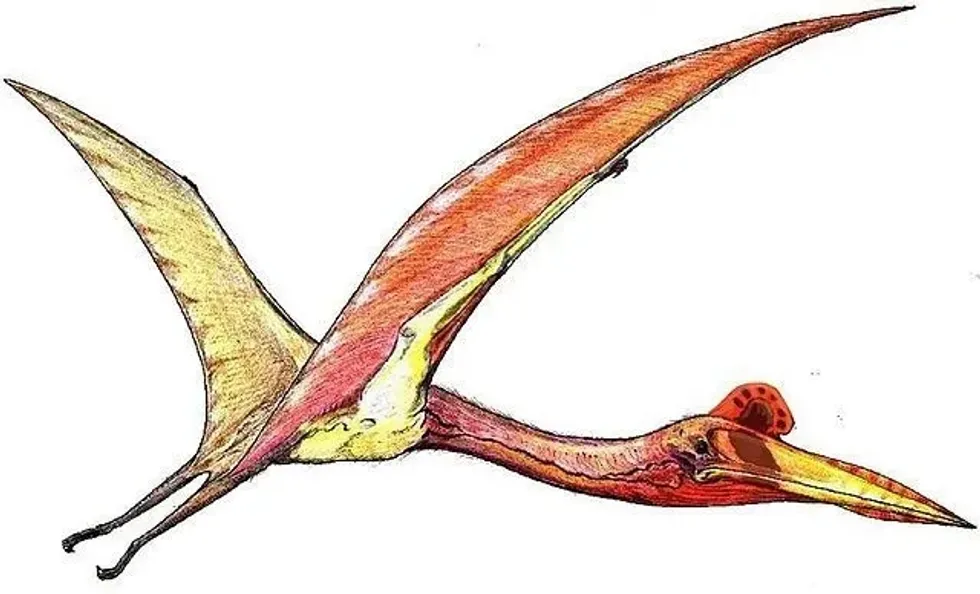Imperial moths (Eacles imperialis) are natives of North America. They are classified in a segment of the giant silkworm family called the royal moths.
During pre-summer, Imperial Moths rise up out of the soil. Both genders are marked with blotches of red, brown, and purple.
Imperial Moth (Eacles imperialis Drury, Saturniidae, ceratocampinae) have been spotted in Jefferson and Suffolk. Their global distribution is from Maine and southern Quebec, south, then to Florida, and west to western Kansas, Texas, and Ontario.
If we compare butterflies and moths in North America, there are about 12,000 Imperial moths species and about 825 species of butterflies in North America.
Pines, oaks, maples, sweetgum, sassafras, eucalyptus, Acer negundo (box elder), and Picea abies (Norway spruce) are Imperial Moth host plants. When it comes to the Imperial moth size, they have a wingspan of 3.15- 6.89 in (80-175 mm), and the female is larger than the male.
Imperial Moth larvae are 10 cm long. Their eggs are white-yellow in color, the Imperial Moth cocoon is thin, papery and the pupae are dark brown in color.
The sub species of Imperial Moths are E. i. imperialis (Drury, 1773), E. i. pini, E. i. cacicus, E. i. hallawachsae, E. i. quintanensis, E. i. decoris , E. i. tucumana, E. i. opaca, E. i. piurensi, E. i. nobilis, E. i. magnifica, and E. i. anchicayensis.
The Imperial Moth life cycle contains four stages: egg, larva, pupa, and adult. The huge Yellow Imperial moth lay eggs in gatherings of 2-5 on the surface of host plants and require 14 days to incubate.
Imperial Moth eggs hatch after 10-14 days. The larvae have five instars; the primary instar survives a brief timeframe.
First-instar larvae seem orange with black bands all across their body and have two huge scoli with white fibers at their ends on the second and third thoracic segments. The second instar has smaller scoli concerning its body which is covered in hair and is darker.
In the Third instar, Scoli keeps on shortening as their body size increases. The color of the head becomes darker.
In the fourth instar, Scoli shortens further, and the hairs on this instar become much larger, and color variations start to occur. In the fifth instar, larvae are fully mature.
Pupae have spines on their back to help rise out of their soil burrow and have a movable abdominal segment. Grown-ups arise before dawn and mate after noon the following day.
If you find this article interesting, do also read our articles on gypsy moth facts or praying mantis facts.
Imperial Moth Interesting Facts
What type of animal is an imperial moth?
The Imperial moth is an insect.
What class of animal does an imperial moth belong to?
The imperial moth (Giant Silkworm Moth) belongs to the Arthropoda phylum and Insecta (insects) class of animal.
How many imperial moths are there in the world?
There are a total of 160,000 species of moths in the world and two subspecies of imperial moth; eacles imperialis pini and eacles imperialis imperialis. But the exact count of the imperial moth is not officially recorded.
Where does an imperial moth live?
Imperial moths are found living around Canada, Argentina, and the southeastern United States.
What is an imperial moth's habitat?
Imperial Moths prefer to live in woodlands, rocky mountains, and the Atlantic coast.
Imperial Moths' habitat ranges from the Rocky Mountains to the Atlantic Coast. In the US, from the rough mountains east to the Atlantic sea. In Canada, its population has been declining since the mid-1900s. Also, many Imperial moths (ceratocampinae) in New England are also declining.
Who do imperial moths live with?
Imperial moths are solitary creatures; hence they live alone.
How long does an imperial moth live?
The Imperial moth life span is about two weeks. Due to the lack of functional mouthparts, they cannot feed themselves.
How do they reproduce?
Male Imperial moths rise from the soil to mate and approach females as they release pheromones. They then go on to mate, and the female finally lays eggs in a few hundred, spread across several trees. The eggs proceed to hatch in about two weeks, and orange caterpillars with black spines emerge and begin consuming the leaves of trees.
What is their conservation status?
The conservation status of an imperial moth is 'Least Concern'.
Imperial Moth Fun Facts
What do imperial moths look like?

The different colors of an adult imperial moth are essentially yellow with red, earthy colored, and purple blotches. They have evolved themselves to look like rotten leaves to blend in with their surroundings, helping them avoid their predators.
Light and dark variations of this species are found in both northern and southern districts of their habitat.
Hatchlings can be around 10–15 mm long, orange in color with dark bands across its body and huge spines in the main instar, and growing up to 3–5.5 inches (75–100 mm) long in the fifth instar with long hairs and more spines.
Their colors keep changing between dark brown and burgundy, with white bands in fixed positions and green with round yellow patches.
How cute are they?
The adult imperial moth is attractive due to its color combination, while caterpillars may be cute to some and gross to others.
How do they communicate?
For both butterflies and moths, communication is important for finding a mate. They cannot rely on vision alone, and hence they use their excellent sense of smell to detect each other. Females release pheromones which are detected by males emerging from the ground.
How big is an imperial moth?
The wingspan of an adult imperial moth is 80-174 mm. Females are larger than males, and the length of larvae can be up to 100 mm.
How fast can imperial moths fly?
Moths can fly up to 400 miles in a single flight. The speed of an imperial moth is not officially recorded.
How much does an imperial moth weigh?
The weight of the imperial moth is not officially measured, but it is safe to assume that they are heavier than butterflies.
What are their male and female names of the species?
For both male and female imperial moths, the species name is E. imperialis. They do not have gender-specific names.
What would you call a baby imperial moth?
A baby Imperial Moth is called a caterpillar or an imperial moth larva. After which, they molt into becoming an imperial moth pupa.
What do they eat?
Larvae eat leaves of bald cypress, basswood, hickory, cedar, oak, birch, honeylocust, maple, elm, pine, sassafras, sweetgum, sycamore, and pecan. The grown-up imperial moth doesn't feed as they lack usable mouthparts.
Are they harmful?
Even though caterpillars may look menacing and dangerous, they don't sting or attack people. Full-grown moths and caterpillars are both harmless.
Would they make a good pet?
Although they are wild creatures of the forest and they can become your little pet worms. You may keep a caterpillar until it fully grows into an imperial moth and then release them into its natural habitat. As these moths do not have a mouth, they won't be able to feed themselves, ending up dying sooner or later.
Did you know...
The life history of the imperial moth (Eacles imperialis) shows that this species was first discovered and recorded by Dru Drury in 1773.
How to raise imperial moth caterpillars?
Caterpillars make incredible transient pets, and watching them as they undergo their progression into moths can be delightful. As you provide imperial moth caterpillar food and a protected nook, they require almost no work to keep them happy as they progress into becoming moths.
Imperial moth caterpillar care can be done by finding out which caterpillars are local to your area. At that point, determine which type of caterpillar you're looking for to keep as pets. After that, research the plants in your yard or region.
Start your hunt in the spring, look for caterpillars eating plants. Catch thw caterpillars and continue to raise them.
What does it mean when you see an imperial moth?
Seeing an imperial moth means it will bring blessings and gifts of truth, wonder, passion, and delight.
Here at Kidadl, we have carefully created lots of interesting family-friendly animal facts for everyone to discover! Learn more about some other arthropods including puss moth, or poodle moth.
You can even occupy yourself at home by drawing one of our moth coloring pages.










